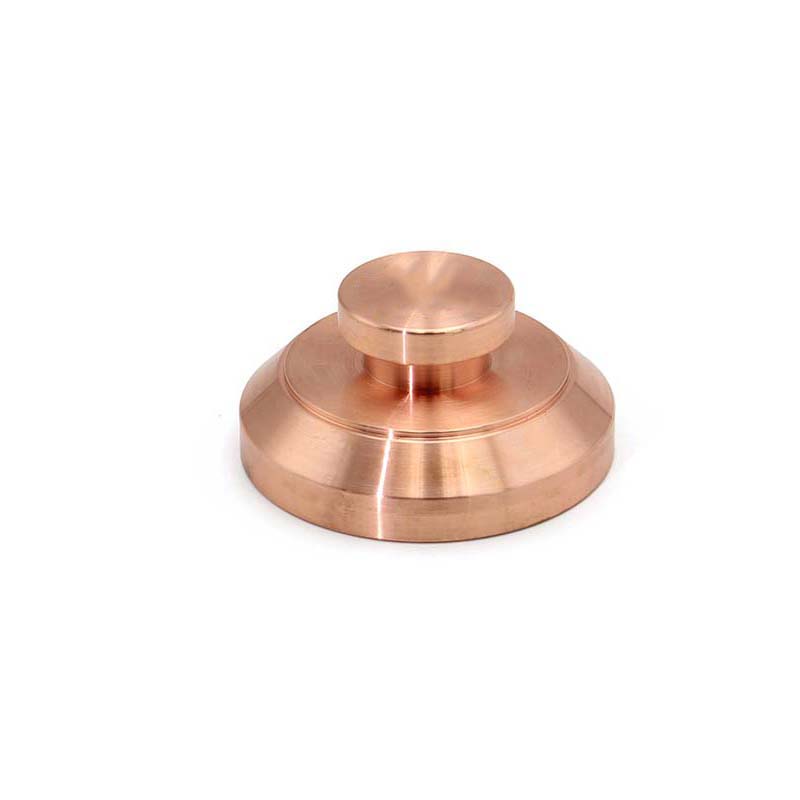What is Copper CNC Milling?
 Copper's unique properties - including its excellent thermal conductivity (401 W/m·K) and Electrical conductivity (5.96×10⁷ S/m) - make it both valuable and challenging to machine compared to other metals.
Copper's unique properties - including its excellent thermal conductivity (401 W/m·K) and Electrical conductivity (5.96×10⁷ S/m) - make it both valuable and challenging to machine compared to other metals.
Key characteristics of copper that affect CNC Milling:
Machinability rating of 20% (compared to 100% for free-machining brass)
Thermal expansion coefficient of 16.5 µm/m·°C
Typical cutting speeds of 150-300 m/min for carbide tools
Feed rates between 0.05-0.2 mm/tooth
Technical Characteristics of Copper CNC Milling
The milling process for copper requires specialized parameters to account for its Material properties:
1. Tool Selection
Carbide end mills with 2-4 flutes are most common, featuring:
Helix angles of 35-45° for optimal chip evacuation
Tool diameters ranging from 0.1 mm to 25 mm for precision work
Coated variants (TiAlN or diamond-like carbon) for extended tool life up to 50% longer
2. Cutting Parameters
Surface speeds: 100-250 m/min for roughing, 150-350 m/min for finishing
Depth of cut: 0.5-3 mm axial, 10-50% of tool diameter radial
Chip loads: 0.025-0.15 mm/tooth depending on copper alloy
3. Surface Finish
Properly machined copper can achieve:
Surface roughness (Ra) values of 0.2-0.8 µm
Mirror finishes with Ra < 0.1 µm using diamond tooling
Form tolerances within 5 µm for precision components
Applications of Copper CNC Milling
1. Electrical Components
Copper's superior conductivity makes it ideal for:
Busbars with current capacities up to 6000 A
High-frequency RF connectors with impedance tolerances of ±1 Ω
Electrode plates for batteries with flatness requirements of 0.02 mm/m²
2. Heat Transfer Systems
Heat sinks with fin densities up to 40 fins/cm
Liquid cooling plates capable of handling 500 W/cm² heat flux
Thermal interface components with surface flatness of 5 µm
3. Industrial Tooling
EDM electrodes with surface finishes of Ra 0.4 µm
Mold cores for plastic injection with tolerances of ±0.01 mm
Welding fixtures capable of withstanding 300°C continuous operation
4. Aerospace Components
Waveguide components with dimensional stability of ±0.002 mm/°C
Thrust chamber liners for rockets operating at 3000°C
Electrical bonding straps with conductivity of 100% IACS
Maintenance and Care for Copper CNC Milling
1. Machine Maintenance
Regular maintenance should include:
Way lubrication every 200 operating hours
Ball screw inspection with backlash measurement (< 0.005 mm tolerance)
Spindle runout checks (< 1 µm TIR at 10,000 RPM)
2. Tool Maintenance
Tool life monitoring: replace after 60-120 minutes of cutting time
Edge inspection under 20× magnification for microchipping
Balancing for tools operating above 15,000 RPM
3. Workpiece Handling
Clean with isopropyl alcohol (≥99% purity) before machining
Use vacuum or non-marking fixtures with holding force of 0.5-1.5 N/mm²
Store in controlled environments (20-25°C, 40-60% RH)
4. Coolant Management
For copper machining:
Use water-soluble coolants at 5-10% concentration
Maintain flow rates of 10-20 L/min per cutting tool
Filter to 10 µm absolute rating
Monitor pH levels between 8.5-9.5





 English
English

